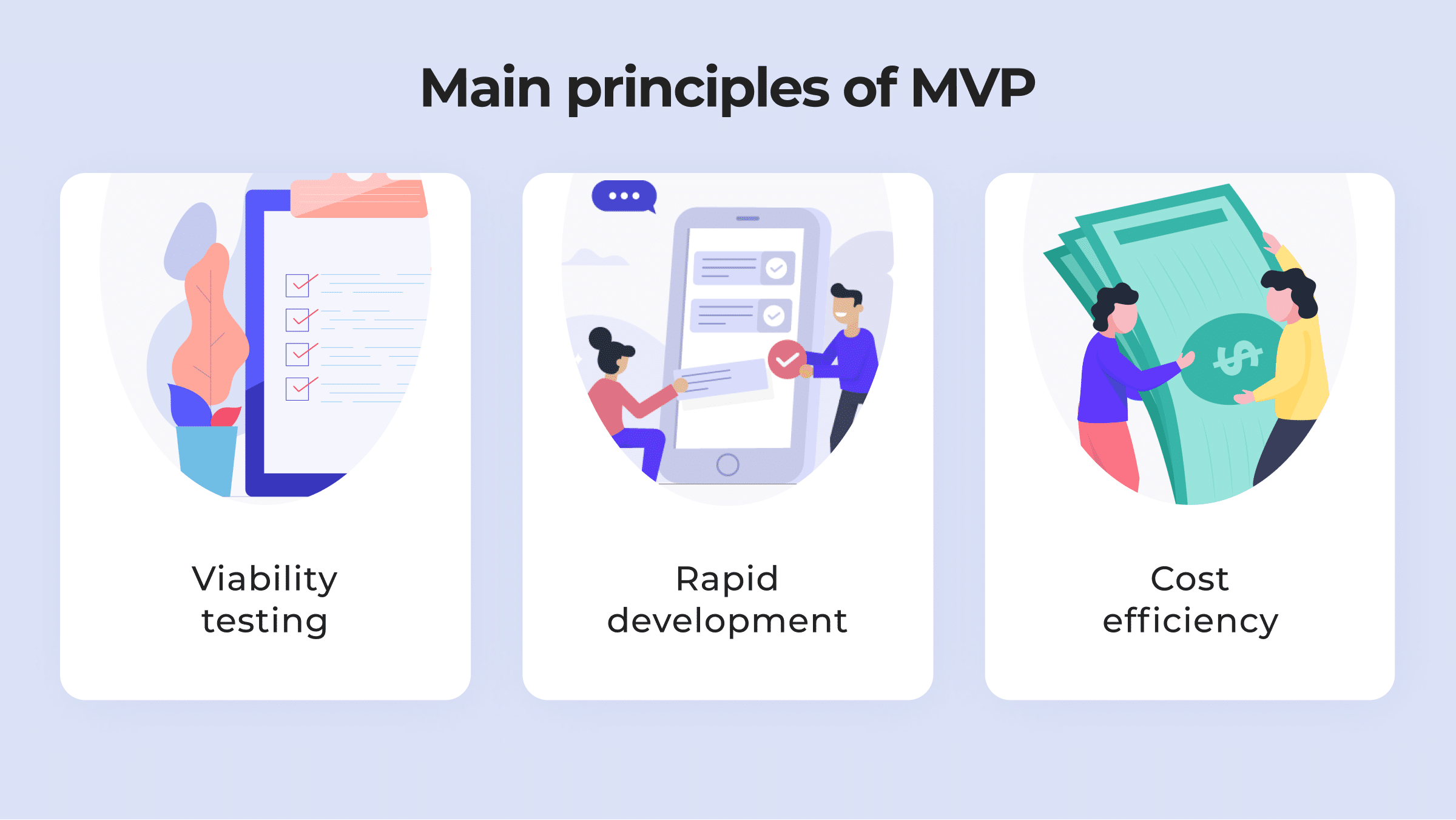Applications often begin with MVP. Minimum viable product is used by app developers and entrepreneurs at the dawn of a digital product’s creation. First of all, MVP is essential to test the app’s usability to prevent going far on the path of development with a serious flaw in the pocket. Besides, this solution plays the leading role among finance raising tools for start-ups as it allows them to find investors with a minimum resources spent. In this article, we’ll talk about MVP’s definition, the way it differs from a prototype, and how to benefit from going for it when launching your digital product.
How to Define an MVP?
A minimum viable product is a demo version of a full-fledged app, shortened to its functional essence. One of the MVPs core principles is that developers only put one or two critical elements of the final product in it while labeling other features as “decorative” or “excessive”. MVP is elaborated to the extent necessary to complete the app’s mission, i.e. address the need of a targeted niche.
While the end goal of every MVP is a full-fledged app, types of the former vary depending on the exact app’s perspective. For example, a landing page can be an MVP as long as it manages to introduce your idea to users and collect their feedback about it.
Still, regardless of the MVP type you choose, it will certainly comply with the 3 following pillars:
- Low development time. One of the MVP’s greatest bonuses is that it enables digital embodiment of your idea with minimal time spent.
- Cost efficient. The price for MVP varies depending on your business’s unique needs, but generally it does not exceed the amount of an average Harward student’s pocket money (yeah, Mark Zuckerberg also started from an MVP).
- Viability verification. Any MVP reveals the ability of your digital product to stay afloat in the highly competitive environment of the nowadays business scene as it tracks users’ interest and their readiness to pay for the offered service.
Why you should start with MVP
The reasoning for making an MVP your next step after the prototyping phase is mostly associated with the ability to gather sufficient feedback about an offered product to see whether it interacts with the user in an intended way. Additionally, feedback obtained at the MVP stage determines your product’s further destiny in terms of financial support. There are 2 main types of feedback collected during the MVP stage that you can leverage in different yet interconnected ways.
Users Feedback. A properly made MVP gives your target audience a chance to try your product out and decide whether it satisfies its corresponding needs in a way convenient from the perspective of design, technological span, paying format, etc.
Investors Feedback. Investors can quickly assess the financial attractiveness of your app by checking an MVP. Time is money and MVP is a drastically shorter way to clarify whether investing now will turn out profitable later in the future.
MVP’s benefits
MVP vs Prototype
Both MVP and a prototype are preparatory versions intended to gather additional resources to supplement the creation of the former. Quite expectedly, misunderstanding of which product performs which function has become a common place of the digital information field. That’s why we have decided to put clarity about basic differences between an MVP and a prototype.
Prototype, also known as a wireframe, refers to the following:
- testing multiple product concepts to select the best one
- choosing an approach to address target audience’s needs
- collecting users feedback to choose core features of an app
- small to zero engineering is involved
- no finance raising takes place
Instead, MVP is known by the next features:
- testing of the chosen product concept
- ensuring target audience’s needs are properly addressed with the chosen approach
- collecting customer’s feedback about the app’s core features
- technical development is included
- assessment of the product by potential investors to decide on further financing
Thus, in contrast to prototyping, where you need to create multiple wireframes of your product to decide on its main technological and design solutions, MVP stage implies leaving this preliminary decision-making behind and heading to their test drive.
How to Approach an MVP?
Here you can find some tips that will help you approach an MVP implementation in the most efficient way.
- When addressing customers’ pain with your MVP, focus on one problem at a time. Tearing around several problems in one MVP is not reasonable as it deprives the solution of its main advantages, such as cost and time effectiveness, along with transparency of the final result.
- Do not seize perfection. We all know how hard it is to turn off our inner perfectionist, but in the MVP’s case, perfection is not ruined by incompleteness. That’s the main difference between an MVP and a full-fledged app: you do not need full functionality installed on the former to leverage its use when testing the viability of the latter.
- Don’t look up at the fancy features of your competitors’ apps when creating your own MVP. Instead, let yourself get inspired by stories of such tech giants as Facebook or Instagram, which, by the way, also started from an MVP. Their further success has its roots in dotwise interacting with their target audience and then letting the positive outcome resonate on the web.
- Pay attention to your users’ feedback. Your users’ opinion about the product you offer is the main indicator of its market value. Thus, it’s vital to consider every feedback that comes into your view from the MVP users and perceive it as a meloman perceives music: in a grasping and attentive manner.
- Know your weapon. At the moment there are several kinds of MVPs and each of them is best at shooting precise goals perceived by app entrepreneurs. For instance, a Video MVP is called to attract users by visual presentation of the product, while a Wizard of Oz MVP is used to create an illusion of full automatisation of service provision while it is in fact manually supported.
Thus, MVP-based approach enables developers and entrepreneurs to test their product at the early stage. Direct communication with potential customers contributes to the clearer understanding of whether the full-fledged app is going to find the market when released. All in all, making an app is like replying to a question asked by your target audience, while MVP is a way to make sure you heard it correctly.




